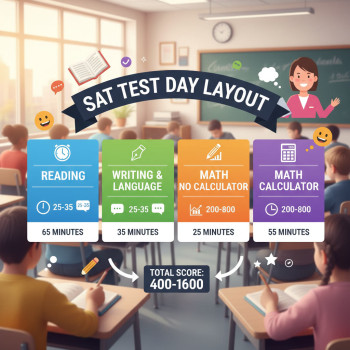Why memory matters more than you think for the SAT
When students think about SAT prep, they often picture endless practice tests, strategy guides, and timed drills. Those things matter, but there’s a quieter, more powerful factor that separates a stressful test day from a confident one: memory. Not just rote memorization, but a strong, flexible memory that helps you retrieve formulas, grammar rules, vocabulary nuances, and patterns under pressure.
The SAT is made of two main parts: Evidence-Based Reading and Writing, and Math. Your score depends on a mix of comprehension, reasoning, and the ability to recall and apply knowledge quickly. Total score ranges from 400 to 1600, and time pressure is constant. When memory is solid, you spend less cognitive energy struggling to remember a rule and more energy applying it correctly. That saves time, reduces anxiety, and raises accuracy.
What strong memory actually means for a student
Strong memory isn’t just having a few facts stored away. It’s about these three things:
- Reliable retrieval: You can pull the right fact or method quickly when you need it.
- Contextual flexibility: You recognize when a memorized idea applies to a new type of problem.
- Long-term retention: The knowledge survives beyond the week before your test.
Imagine sitting down for a math section and instantly recalling the quadratic formula without fumbling. Or seeing a sentence in the Writing section and immediately applying the correct parallelism rule because the memory is automatic. That fluency is the competitive edge.
Real-world gains: why improved recall matters on test day
Better memory reduces cognitive load. When you aren’t using mental energy searching for a verb tense rule or a geometry identity, you free up working memory to think through multi-step problems. That’s huge—especially on long SAT questions that require juggling several pieces of information at once.
Additionally, reliable memory helps build momentum. Every question you answer quickly and confidently reinforces your focus and lowers test anxiety. The result is often more correct answers in the same time, translating directly into higher scores.
Memory strategies that actually work (backed by cognitive science)
There are plenty of study fads, but some techniques consistently outperform others. Here are the most effective memory strategies for SAT prep—and how to use them in practice.
1. Active recall: test yourself early and often
Active recall means prompting your brain to retrieve information rather than passively rereading it. For the SAT, that means using flashcards, practice questions, and closed-book recall sessions.
- Example: Instead of reading a list of grammar rules, write a rule on one side of a flashcard and an example on the other. Try to state the rule aloud before flipping the card.
- Math example: Cover your notes and try to derive the formula for the area of a triangle or expand (x + y)2 from memory.
2. Spaced repetition: let time do the heavy lifting
Spaced repetition spaces practice sessions across increasing intervals to strengthen long-term retention. It’s particularly useful for vocabulary, grammar rules, and formula recall.
Use a system that brings a card back after 1 day, then 3 days, then a week, then a month. Combining spaced repetition with active recall embeds knowledge more deeply than cramming.
3. Interleaving: mix topics to build flexible memory
Instead of practicing 30 algebra problems followed by 30 geometry problems, mix them. Interleaving forces your brain to choose the right approach on the fly, which better mimics test conditions.
Interleaving improves the ability to recognize which method applies to a given problem type—exactly what you need on the SAT, where questions appear in unpredictable sequences.
4. Elaboration and generation: explain, connect, and create
Elaboration means connecting a new fact to something you already know. Generation is producing answers from scratch. Both deepen memory.
- Vocabulary: Don’t memorize only definitions. Generate your own sentence for each word and connect it to a personal experience.
- Math: When you learn the Pythagorean theorem, derive it visually or explain why it works instead of just memorizing a2 + b2 = c2.
5. Mnemonics and chunking: make memory effortless
Mnemonics transform abstract information into memorable hooks. Chunking groups related elements together to reduce cognitive load.
- Grammar: Create short phrases for lists of rules (e.g., a small phrase for the most common comma rules).
- Math formulas: Group formulas by topic—algebra, coordinate geometry, statistics—and memorize them as a set rather than isolated items.
6. Dual coding: pair words with visuals
Pairing a definition or step with a picture helps memory. Draw small diagrams for common SAT question types like function transformations or passage structure maps for reading sections.
7. Retrieval under stress: practice like the test
Practicing in conditions similar to test day—timed sections, quiet setting, minimal breaks—teaches your memory to work under pressure. That reliability is what you want when the clock is ticking.
How to build a memory-first SAT study plan
Memory strategies are most effective when they’re part of a deliberate, time-bound plan. Here’s a step-by-step framework you can adapt to your timeline.
Step 1: Audit your memory needs
Start with a diagnostic test. Note what you can’t recall consistently—vocabulary, specific grammar rules, algebra manipulations, geometry facts. Those are your memory targets.
Step 2: Create a spaced-repetition schedule
Assign each target to a spaced-repetition cycle. Prioritize high-impact items: common grammar rules, core algebra techniques, high-frequency vocabulary.
Step 3: Interleave practice and test retrieval
Mix question types during practice sessions and force retrieval without notes. Use short daily recall routines for quick wins.
Step 4: Use mixed-format review sessions
Combine flashcards, practice problems, and short written explanations in the same session. This variety strengthens memory in different ways.
Step 5: Measure, adjust, and reinforce
Track which items you forget and increase review frequency for those. Over time, transfer items from frequent review to maintenance review.
A simple spaced-repetition calendar (table)
Below is a sample four-week cycle you can apply to vocabulary, formulas, or rules. Think of “Day 0” as the day you first learn the item.
| Day | Action | Goal |
|---|---|---|
| Day 0 | Initial learning (active recall + elaboration) | Understand and encode the item |
| Day 1 | Quick review (flashcards, test yourself) | First reinforcement |
| Day 3 | Practice in context (mixed problems) | Apply knowledge |
| Day 7 | Retrieve without notes (timed) | Strengthen retrieval under mild stress |
| Day 14 | Mixed review + interleaving | Enhance transferability |
| Day 30 | Maintenance review | Long-term retention |
Comparing memory techniques: what to prioritize
Not all techniques yield the same return on time invested. Here’s a compact look at popular strategies and how they perform for SAT prep.
| Technique | Effectiveness | Time Investment | Best uses |
|---|---|---|---|
| Spaced repetition | Very high | Moderate ongoing effort | Vocabulary, formulas, rules |
| Active recall (flashcards, practice tests) | Very high | Moderate | All SAT content |
| Interleaving | High | Low to moderate | Problem selection, application |
| Elaboration & generation | High | Moderate | Deep understanding, complex concepts |
| Mnemonics & chunking | Moderate | Low | Lists, small sets of rules |
| Passive rereading | Low | Low | Quick refresh (not for deep learning) |
Practical examples that bring memory techniques to life
Vocabulary: from word lists to living words
Instead of memorizing 200 words in a single night, pick 20–30 each week and use spaced repetition. For each word:
- Create a flashcard with the definition on the back.
- Write one original sentence that uses the word in a personal or vivid context.
- Draw a tiny symbol next to the word to create a visual cue (dual coding).
This combination of active recall, elaboration, and visual association creates multiple ways to retrieve the word during the Reading and Writing sections.
Math formulas: derive before you memorize
Take ten minutes to derive a formula before committing it to memory. If you derive the quadratic formula once, you’ll remember the path and the logic, which helps you reconstruct it if you forget a sign or coefficient. Pair that with flashcard retrieval and occasional derivations to cement the formula.
Reading and grammar: chunk rules into patterns
Group grammar rules by the type of fix they provide: agreement, sentence structure, punctuation, and usage. Create short chunked cues—three to four per category—and quiz yourself on spotting the category first, then the rule. That helps your brain decide where to focus when scanning answer choices quickly.
Test-day memory hacks
Memory training pays dividends on test day if you practice memory under realistic conditions. Here are a few practical hacks to make retrieval smoother:
- Pre-test ritual: A short 5-minute rapid retrieval drill (flashcards or a quick problem set) warms up your recall muscles.
- Write key formulas: If allowed, jot key formulas and small mnemonics on scratch paper immediately after you receive the booklet. Even the act of writing strengthens memory.
- Use micro-cues: Create tiny visual reminders in your scratch work (like a circled symbol) to cue a multi-step approach for common problem types.
- Pause and breathe: Stress impairs retrieval. A 10-second deep-breathing technique can restore calm and bring memory back online.
When personalized help makes the difference
All these strategies are powerful on their own, but the best results come from tailored application. That’s where personalized tutoring can help students accelerate. Tutors who diagnose a student’s unique memory gaps, prioritize the most impactful facts to memorize, and design a review schedule can turn scattered effort into measurable improvement.
For example, Sparkl’s personalized tutoring blends 1-on-1 guidance, tailored study plans, expert tutors, and AI-driven insights to identify the high-impact items a student is likely to forget and schedule optimal review intervals. That means less guesswork and more efficient progress—especially useful when test dates are tight.
Balancing memory and understanding
Memory is a tool, not a substitute for comprehension. Memorizing formulas without understanding when they apply is risky. Aim for a balance: use memory to make retrieval automatic, and use understanding to ensure correct application.
In practice, that means pairing memorization with problem-solving. After you learn a formula, immediately solve 3–5 problems that require it. Then revisit those problems in spaced intervals. This combination creates both recall and conditional knowledge—knowing not just the fact, but the situations where it matters.
Common pitfalls and how to avoid them
- Over-reliance on cramming: It can give a short-term boost but fails to support long-term retention. Prefer spaced practice.
- Passive review: Rereading notes feels productive but yields weak recall. Swap in active recall sessions.
- Ignoring weak items: If you avoid hard facts you always forget, they never improve. Emphasize weak points in your review cycle.
- One-size-fits-all plans: Every student’s memory profile is different. Personalized plans, like those a tutor can create, increase efficiency.
Putting it all together: a one-week memory-focused microplan
Here’s a practical microplan you can repeat each week to steadily build memory for the SAT.
- Day 1: Diagnostic (60 minutes). Identify 10 vocabulary words, 5 grammar rules, and 5 math formulas you struggle with.
- Day 2: Encode (45 minutes). Use active recall and elaboration to learn items. Create flashcards and 1–2 original examples per item.
- Day 3: Apply (60 minutes). Work mixed practice problems and use the items in context.
- Day 4: Spaced review (30 minutes). Quick recall session for Day 2 items; adjust intervals for hard items.
- Day 5: Interleave practice (60 minutes). Mix problem types under timed conditions.
- Day 6: Retrieval practice (30 minutes). Timed short quiz; simulate test stress briefly.
- Day 7: Reflect and plan (30 minutes). Review what stuck and schedule the next cycle.
Final thoughts: memory as an advantage, not a shortcut
Strong memory in SAT prep is not about memorizing everything. It’s about building a foundation of reliable recall that lets you apply reasoning faster and more accurately. When memory is organized—via spaced repetition, active recall, interleaving, and meaningful elaboration—it becomes a strategic advantage, reducing anxiety and improving performance.
And remember: personalized support can speed this process. Tutors who assess your individual needs, craft tailored study plans, and use AI-driven insights to optimize review schedules help you spend time where it matters most. That way, you’re not just studying harder—you’re studying smarter.


Start small, stay consistent, and let memory work for you. The SAT rewards preparation that combines understanding with reliable recall—so prioritize memory, practice with intent, and give yourself the calm confidence you want on test day.













No Comments
Leave a comment Cancel